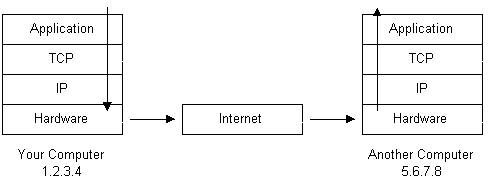Protocol Stacks and Packets
So your computer is connected to the Internet and has a unique address. How does it 'talk' to other computers connected to the Internet?
An example should serve here: Let's say your IP address is 1.2.3.4 and you want to send a message to the computer 5.6.7.8. The message you want to send is "Hello computer 5.6.7.8!". Obviously, the message must be transmitted over whatever kind of wire connects your computer to the Internet. Let's say you've dialed into your ISP from home and the message must be transmitted over the phone line. Therefore the message must be translated from alphabetic text into electronic signals, transmitted over the Internet, then translated back into alphabetic text. How is this accomplished? Through the use of a protocol stack.
Every computer needs one to communicate on the Internet and it is usually built into the computer's operating system (i.e. Windows, Unix, etc.). The protocol stack used on the Internet is refered to as the TCP/IP protocol stack because of the two major communication protocols used. The TCP/IP stack looks like this:
| Protocol Layer | Comment |
|---|---|
| Application Protocols Layer | Protocols specific to applications such as WWW, email, etc |
| Transmission Control Protocol Layer | TCP directs packets to a specific application on a computer using a port number |
| Internet Protocol Layer | IP directs packets to a specific computer using IP address |
| Hardware Layer | Convert binary packet data to network signals and back (Ethernet network card, modem, etc) |
How They Work
If we were to follow the path that the message "Hello computer 5.6.7.8!" took from our computer to the computer with IP address 5.6.7.8, it would happen something like this:

The message would start at the top of the protocol stack on your computer and work it's way downward.
- If the message to be sent is long, each stack layer that the message passes through may break the message up into smaller chunks of data. This is because data sent over the Internet (and most computer networks) are sent in manageable chunks. On the Internet, these chunks of data are known as packets.
- The packets would go through the Application Layer and continue to the TCP layer. Each packet is assigned a port number. Ports will be explained later, but suffice to say that many programs may be using the TCP/IP stack and sending messages. We need to know which program on the destination computer needs to receive the message because it will be listening on a specific port.
- After going through the TCP layer, the packets proceed to the IP layer. This is where each packet receives it's destination address, 5.6.7.8.
- Now that our message packets have a port number and an IP address, they are ready to be sent over the Internet. The hardware layer takes care of turning our packets containing the alphabetic text of our message into electronic signals and transmitting them over the phone line.
- On the other end of the phone line your ISP has a direct connection to the Internet. The ISPs router examines the destination address in each packet and determines where to send it. Often, the packet's next stop is another router. More on routers and Internet infrastructure later.
- Eventually, the packets reach computer 5.6.7.8. Here, the packets start at the bottom of the destination computer's TCP/IP stack and work upwards.
- As the packets go upwards through the stack, all routing data that the sending computer's stack added (such as IP address and port number) is stripped from the packets.
- When the data reaches the top of the stack, the packets have been re-assembled into their original form, "Hello computer 5.6.7.8!"
